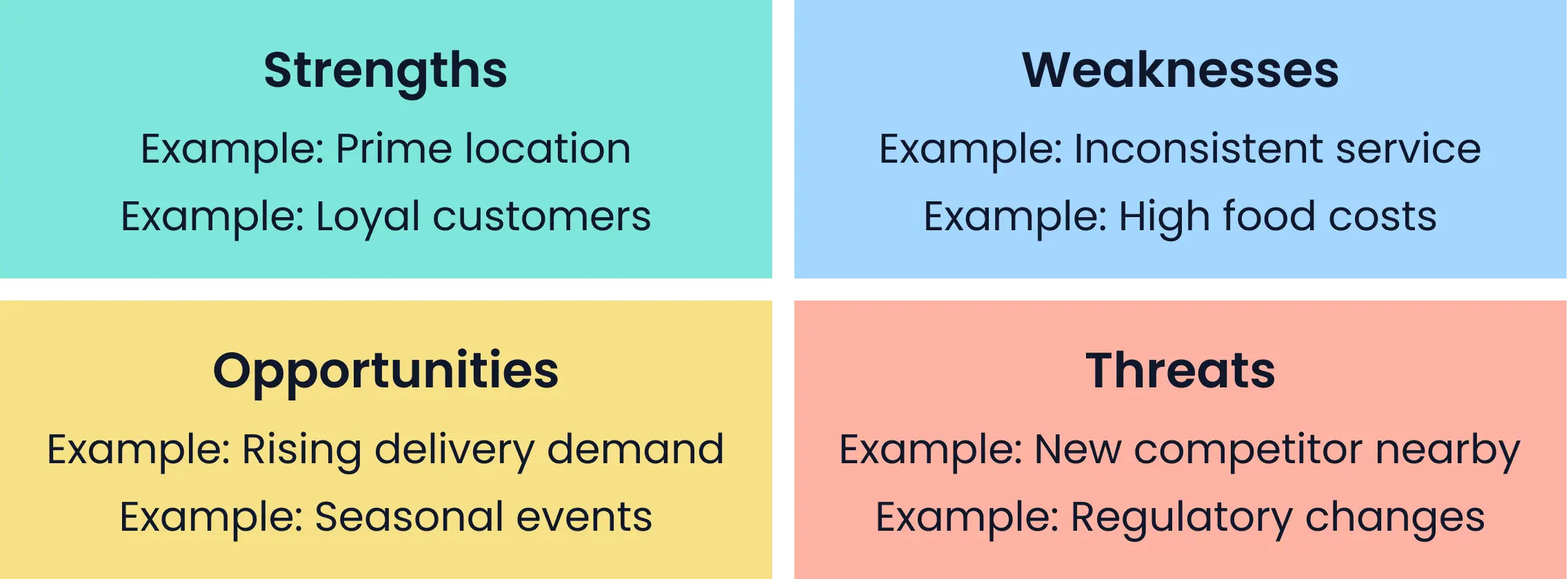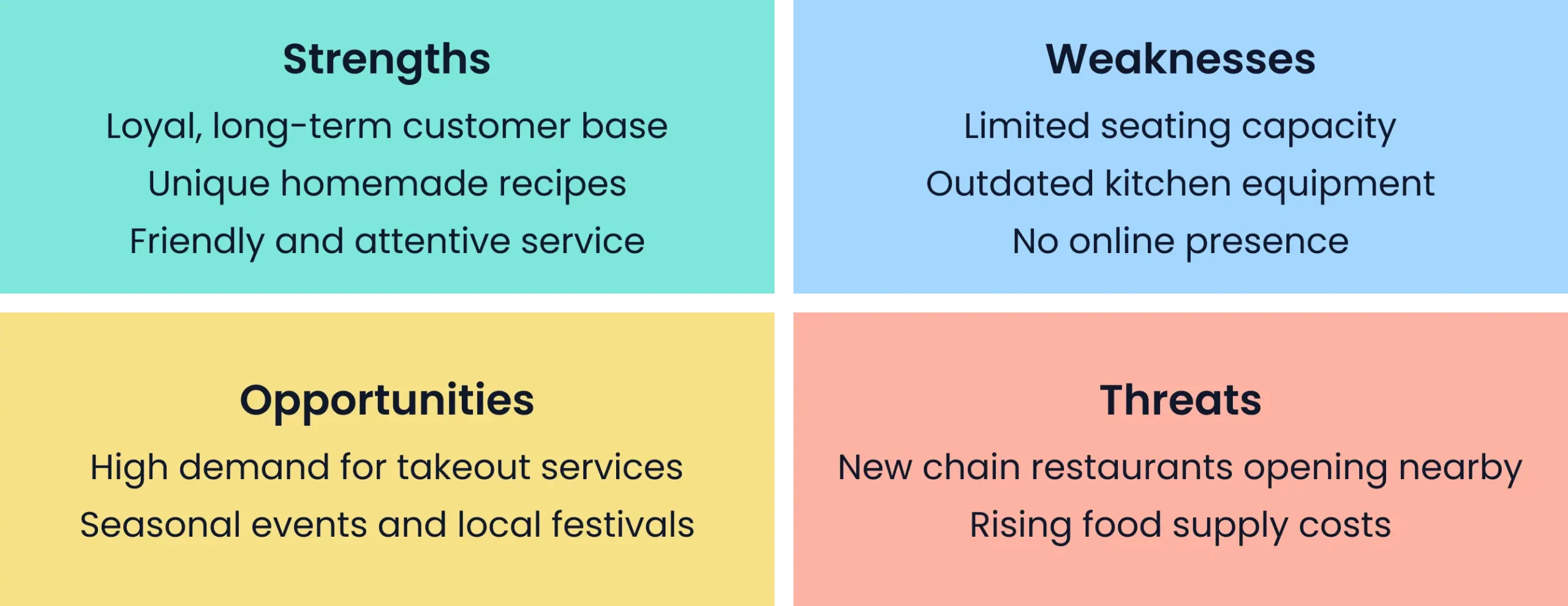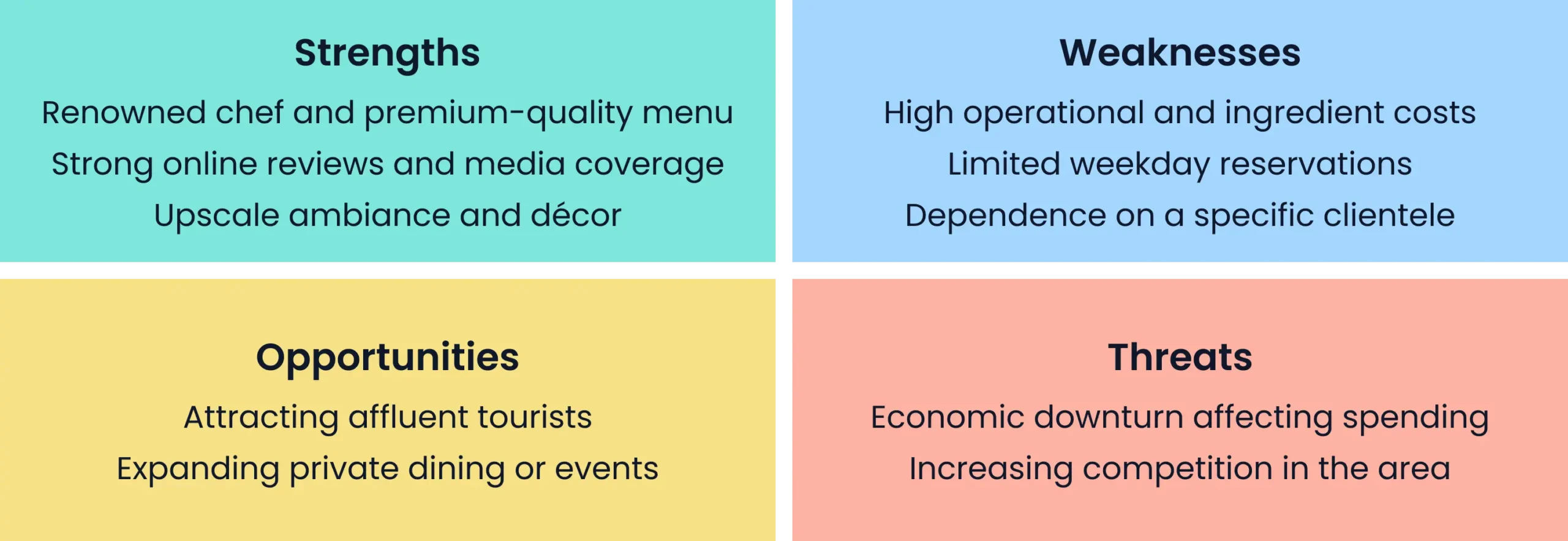

What is SWOT Analysis and How to Do a SWOT Analysis for Your Restaurant?
In the competitive world of the restaurant industry, success hinges on more than just great food and service. To thrive, restaurant owners must adopt strategic planning tools that provide clarity and direction. One such tool is SWOT analysis—a proven method for assessing your business’s internal strengths and weaknesses while identifying external opportunities and threats.
Whether you’re running a cozy café, a bustling diner, or a fine-dining establishment, a SWOT analysis helps you understand where your restaurant stands in a dynamic market. By taking a structured approach, you can make informed decisions, prioritize resources effectively, and position your restaurant for sustainable growth.
In this guide, we’ll explore what a SWOT analysis is, why it’s essential for your restaurant, and how you can conduct one to create actionable strategies for success. Let’s dive in!
What is SWOT Analysis?
SWOT analysis is a strategic planning framework used by businesses to evaluate their internal and external environments. It helps identify what your restaurant is doing well, where improvements are needed, and what opportunities or threats exist in the competitive landscape. By examining these factors, you can create actionable strategies tailored to your restaurant’s unique situation.
Definition of SWOT Analysis
SWOT stands for:
- Strengths – Internal attributes or resources that give your restaurant a competitive edge.
- Weaknesses – Internal factors that may hinder your business performance.
- Opportunities – External conditions that your restaurant can exploit for growth.
- Threats – External challenges that could negatively impact your restaurant.
SWOT analysis originated in the business world as a tool for corporate planning, but its simplicity and versatility have made it invaluable for small businesses, including restaurants. By creating a structured framework, it helps you prioritize actions based on what matters most.
Why SWOT Analysis is Essential for Restaurants
Conducting a SWOT analysis is crucial for restaurant owners because:
- It provides clarity about your restaurant’s market position.
- It helps identify key priorities for growth and improvement.
- It offers a proactive approach to addressing challenges.
- It ensures resources are allocated effectively for maximum impact.
For example, identifying your strengths—such as a prime location or a signature dish—allows you to build marketing strategies that emphasize these advantages. Similarly, understanding weaknesses like inconsistent service or limited seating can guide your operational improvements.
Takeaway: SWOT analysis equips you with actionable insights, enabling you to make data-driven decisions that align with your restaurant’s long-term goals.
Key Components of a SWOT Analysis
A successful SWOT analysis breaks down your restaurant’s situation into four distinct categories: strengths, weaknesses, opportunities, and threats. Each component plays a critical role in shaping your strategy and understanding how to position your business in a competitive market.
Understanding Strengths
Strengths are the internal factors that set your restaurant apart and give you a competitive edge. These are assets, resources, or capabilities that contribute positively to your operations.
Examples of strengths for restaurants:
- Unique menu offerings or signature dishes.
- Prime location in a high-traffic area.
- Experienced and well-trained staff.
- High customer loyalty or repeat business.
- Strong brand recognition or positive reviews online.
Questions to identify strengths:
- What does your restaurant do better than competitors?
- What resources or assets do you have that others lack?
- What aspects of your business receive the most praise from customers?
Understanding your strengths allows you to leverage them in marketing and operations, ensuring you maximize their potential for growth.
Recognizing Weaknesses
Weaknesses are the internal challenges that can hinder your restaurant’s performance. Identifying them is the first step toward improvement.
Examples of weaknesses for restaurants:
- Inconsistent service quality.
- Limited seating capacity or parking.
- High operational costs or inefficiencies.
- Lack of online presence or digital marketing strategy.
- Outdated menu or lack of dietary options.
Questions to identify weaknesses:
- What do customers often criticize about your restaurant?
- Are there any recurring issues with staff, equipment, or supplies?
- Where are you losing money or missing opportunities?
By addressing weaknesses head-on, you can create solutions that enhance your restaurant’s overall performance.
Exploring Opportunities
Opportunities are external factors in the market that your restaurant can capitalize on to grow or improve. These can arise from industry trends, customer preferences, or new technologies.
Examples of opportunities for restaurants:
- Expanding into delivery or online ordering services.
- Partnering with local businesses or influencers for promotions.
- Offering menu options for dietary trends (e.g., vegan, gluten-free).
- Capitalizing on seasonal events or festivals.
- Implementing sustainability practices to attract eco-conscious customers.
Questions to identify opportunities:
- Are there unmet needs in your local market?
- What industry trends can your restaurant adopt?
- Are there new tools or technologies to improve operations?
Seizing opportunities enables your restaurant to stay relevant and competitive in a fast-evolving market.
Analyzing Threats
Threats are external factors that could negatively impact your restaurant’s success. These require strategic planning to minimize their impact or turn them into opportunities.
Examples of threats for restaurants:
- Increased competition from new restaurants in the area.
- Rising food costs or supply chain disruptions.
- Changes in customer preferences or dining habits.
- Regulatory changes or economic downturns.
- Negative online reviews affecting reputation.
Questions to identify threats:
- What external factors could harm your business?
- Are there new competitors entering the market?
- What risks do economic or regulatory changes pose to your operations?
Understanding threats allows you to develop contingency plans, ensuring your restaurant remains resilient in challenging times.
Takeaway: By examining these four components in detail, you gain a comprehensive understanding of your restaurant’s position and can create actionable strategies to enhance strengths, address weaknesses, exploit opportunities, and mitigate threats.
Benefits of SWOT Analysis for Restaurants
A SWOT analysis provides restaurant owners with valuable insights to help streamline operations, improve customer satisfaction, and stay competitive. By evaluating both internal and external factors, this strategic tool empowers you to make informed decisions that drive growth and long-term success.
Aligning Business Goals with Reality
SWOT analysis bridges the gap between where your restaurant currently stands and where you want it to be.
- Clarifies priorities: By identifying your strengths and weaknesses, you can focus on areas with the most significant impact.
- Sets realistic goals: Understanding opportunities and threats ensures your objectives align with market conditions.
- Guides resource allocation: Strengths and weaknesses help you determine where to allocate time, money, and effort.
Example: If a restaurant’s strength is a loyal customer base but its weakness is slow service, focusing on staff training aligns with maintaining customer loyalty and improving operational efficiency.
Adapting to Market Changes
The restaurant industry is constantly evolving, and a SWOT analysis ensures you remain agile and competitive.
- Spot trends early: Opportunities like new dietary trends or delivery options can be seized before competitors.
- Proactively address threats: By recognizing external risks, you can develop strategies to mitigate them before they escalate.
- Enhance resilience: A clear understanding of challenges helps you stay prepared for shifts in customer behavior or economic changes.
Example: A restaurant noticing a rise in plant-based dining can create vegan options to capture this growing customer base while staying ahead of competitors.
Building a Stronger Competitive Edge
SWOT analysis highlights what makes your restaurant unique, allowing you to strengthen your market position.
- Leverage strengths: Use standout features like a unique menu or excellent location in your branding and marketing campaigns.
- Address weaknesses: Implement solutions that turn operational inefficiencies into strengths.
- Differentiate effectively: By capitalizing on your strengths and opportunities, you create a distinct identity that attracts customers.
Example: A restaurant with a prime location but outdated decor can renovate to align with current customer preferences, enhancing its appeal while leveraging its location advantage.
Takeaway: SWOT analysis equips your restaurant with actionable insights to align goals, adapt to changes, and build a competitive advantage. Regularly conducting this analysis ensures your business remains proactive, resilient, and poised for success.
How to Conduct a SWOT Analysis for Your Restaurant
Performing a SWOT analysis for your restaurant involves a systematic process that ensures you gather meaningful insights to drive strategic decisions. Here’s a step-by-step guide to conducting an effective SWOT analysis.
Step 1: Assemble the Right Team
A successful SWOT analysis requires input from diverse perspectives.
- Include key stakeholders such as:
- Managers who oversee operations.
- Chefs and kitchen staff for insights on menu and resources.
- Front-of-house staff for customer feedback.
- Encourage open discussion to identify strengths, weaknesses, opportunities, and threats.
Tip: Consider holding a brainstorming session where everyone can share ideas. Collaborative input ensures a more comprehensive analysis.
Step 2: Gather Relevant Data
Before diving into the SWOT framework, collect data to back your insights.
Internal data sources:
- Customer feedback forms and online reviews.
- Sales reports to identify best-selling and low-performing items.
- Employee feedback on operational challenges.
External data sources:
- Competitor analysis to understand market positioning.
- Industry reports on trends such as sustainability or delivery services.
- Local demographics and customer behavior studies.
Tip: Use surveys or third-party tools to gather unbiased customer opinions and market data.
Step 3: Create a SWOT Matrix
Organize your findings into a clear and concise SWOT matrix:

This simple 2×2 grid helps visualize all aspects of your analysis, making it easier to prioritize.
Step 4: Analyze and Prioritize Insights
Once you’ve filled out your SWOT matrix, focus on the most impactful elements.
Questions to ask:
- Which strengths can be leveraged immediately to enhance operations?
- What weaknesses need urgent attention to avoid further issues?
- Which opportunities align with your restaurant’s goals and resources?
- What threats pose the greatest risk, and how can you mitigate them?
Tip: Rank each item by importance and feasibility to create a clear action plan.
Step 5: Develop an Action Plan
Turn your SWOT insights into specific, actionable strategies.
Example strategies based on SWOT:
- Leverage strengths: Use your strong social media following to promote new menu items.
- Address weaknesses: Invest in staff training to improve service consistency.
- Exploit opportunities: Launch a partnership with a local delivery app to capture the growing online ordering market.
- Mitigate threats: Adjust menu pricing to offset rising food costs and maintain profitability.
Tip: Break down each strategy into short-term and long-term goals for better implementation.
Takeaway: Conducting a SWOT analysis is a structured yet flexible process that helps restaurant owners gain valuable insights into their business. By following these steps, you can identify actionable strategies to drive growth and tackle challenges effectively.
Common Mistakes in SWOT Analysis
While SWOT analysis is a powerful tool, its effectiveness depends on how well it’s executed. Avoiding common pitfalls ensures that your insights are accurate, actionable, and meaningful for your restaurant’s success.
Overlooking Team Input
One of the most significant mistakes is conducting a SWOT analysis without involving the right people.
- Why this matters:
- A single perspective may miss critical insights.
- Front-line staff and managers often have valuable, hands-on knowledge.
- How to avoid it:
- Include team members from all levels, such as chefs, servers, and marketing staff.
- Foster an open environment where everyone feels comfortable sharing feedback.
Example: Your staff may identify operational inefficiencies that management might overlook, such as delays caused by outdated kitchen equipment.
Being Too Vague or Too Optimistic
SWOT analysis is most effective when it’s specific and realistic.
- Common pitfalls:
- Listing generic strengths like “good food” instead of detailing what makes it exceptional.
- Overlooking weaknesses or inflating strengths due to bias.
- How to avoid it:
- Use data and evidence to back your points (e.g., customer reviews or sales trends).
- Be honest about weaknesses—acknowledging them is the first step to improvement.
Example: Instead of noting “strong brand,” highlight specifics like “400+ 5-star reviews on Google.”
Ignoring External Factors
Focusing solely on internal factors can lead to a lopsided analysis.
- Why this matters:
- External opportunities and threats often shape the competitive landscape.
- Missing these factors can lead to unpreparedness for market changes.
- How to avoid it:
- Regularly analyze competitors, market trends, and customer preferences.
- Stay updated on local regulations and economic conditions.
Example: If a competitor is launching a new restaurant nearby, it’s vital to prepare strategies to retain your customer base.
Failing to Prioritize Findings
A long list of strengths, weaknesses, opportunities, and threats without prioritization can overwhelm decision-making.
- Common pitfalls:
- Treating all elements as equally important.
- Attempting to address every issue simultaneously.
- How to avoid it:
- Rank each item based on its potential impact and feasibility.
- Focus on the top 2-3 points in each category for actionable planning.
Example: If high food costs are a major weakness, addressing it with supplier negotiations should take precedence over minor decor upgrades.
Not Updating SWOT Analysis Regularly
A one-time SWOT analysis can quickly become outdated in the dynamic restaurant industry.
- Why this matters:
- Market conditions, customer preferences, and competition evolve constantly.
- Outdated analysis may lead to irrelevant strategies.
- How to avoid it:
- Schedule regular reviews (e.g., quarterly or annually).
- Update your SWOT analysis whenever there are major changes, like a new competitor or a menu revamp.
Example: Adapting your analysis to include rising delivery trends ensures you stay competitive in the current market landscape.
Takeaway: Avoiding these common mistakes ensures your SWOT analysis is both accurate and actionable. By engaging your team, staying specific, and updating insights regularly, you can use SWOT analysis as a powerful tool for guiding your restaurant’s success.
Best Practices for Restaurant SWOT Analysis
To make your SWOT analysis as effective as possible, following best practices can help ensure you gain actionable insights and drive meaningful results. By incorporating these techniques, you can maximize the value of your analysis and position your restaurant for long-term success.
Regular Reviews and Updates
A one-time SWOT analysis is insufficient in a constantly evolving restaurant industry.
Why it’s important:
- Customer preferences, market conditions, and competition change frequently.
- New opportunities or threats can arise at any time.
Best practices:
- Set a review schedule: Perform SWOT analysis quarterly or biannually.
- Update after major events: Revise your analysis following significant changes, such as a menu overhaul, staff restructuring, or new competition.
Example: If a nearby competitor launches a loyalty program, updating your SWOT can help you respond with competitive strategies.
Involve Key Stakeholders
SWOT analysis works best when it incorporates diverse perspectives.
Why it’s important:
- Different team members bring unique insights based on their roles.
- Collaboration ensures no critical aspect is overlooked.
Best practices:
- Include managers, chefs, front-of-house staff, and even loyal customers for input.
- Hold brainstorming sessions to encourage open and honest discussions.
Example: Your front-of-house team might identify weaknesses in service speed, while the kitchen staff could highlight challenges with equipment or workflow.
Use Data to Back Your Findings
SWOT analysis should be based on evidence, not assumptions.
Why it’s important:
- Data-driven insights ensure accuracy and credibility.
- Helps avoid overestimating strengths or underestimating threats.
Best practices:
- Collect data from:
- Customer feedback and online reviews.
- Sales performance reports.
- Industry trends and competitor analysis.
- Use tools like POS systems and market research platforms to gather insights.
Example: Instead of assuming your menu is a strength, confirm it with data showing your best-selling dishes and positive customer reviews.
Focus on Actionable Insights
Your SWOT analysis should lead to clear, practical steps.
Why it’s important:
- Identifying issues without solutions limits the value of your analysis.
- Actionable insights directly impact your restaurant’s performance.
Best practices:
- Prioritize findings by importance and feasibility.
- Turn insights into specific, measurable goals.
Example: If rising delivery demand is an opportunity, develop an action plan to partner with delivery platforms or improve packaging for takeout orders.
Integrate SWOT with Overall Strategy
SWOT analysis should complement your broader business planning efforts.
Why it’s important:
- Ensures alignment with long-term goals.
- Helps streamline decision-making and resource allocation.
Best practices:
- Link SWOT insights to marketing, operations, and customer service strategies.
- Use findings to guide investments in staff, technology, or menu development.
Example: If sustainability is identified as an opportunity, integrate eco-friendly practices into your operations and promote them in your marketing campaigns.
Leverage Technology for Better Insights
Modern tools can enhance the efficiency and accuracy of your SWOT analysis.
Why it’s important:
- Simplifies data collection and analysis.
- Provides real-time insights into performance and market trends.
Best practices:
- Use POS systems to analyze sales trends.
- Leverage customer relationship management (CRM) tools to track feedback.
- Explore SWOT templates and visualization tools for better presentations.
Example: A POS system showing low-performing menu items could highlight weaknesses, prompting you to refine your offerings.
Takeaway: By following these best practices, you can conduct a thorough and impactful SWOT analysis for your restaurant. Regular reviews, data-driven insights, actionable strategies, and alignment with your overall goals will help you stay ahead in the competitive restaurant industry.
Examples of SWOT Analysis for Restaurants
Real-world examples of SWOT analysis provide valuable context for understanding how this tool can be applied to your restaurant. Below are two case studies highlighting how SWOT analysis works in different types of establishments.
Case Study: Family-Owned Diner
This example illustrates how a small, family-run restaurant can use SWOT analysis to stay competitive in its local market.
SWOT Analysis Matrix:

Key Insights:
- Leverage strengths: Highlight homemade recipes and personalized service in marketing campaigns.
- Address weaknesses: Invest in upgrading kitchen equipment to improve efficiency and expand seating options.
- Capitalize on opportunities: Launch a takeout menu and collaborate with local events to increase visibility.
- Mitigate threats: Create loyalty programs to retain regular customers amidst increased competition.
Case Study: Upscale Fine Dining Restaurant
This example demonstrates how a high-end restaurant can use SWOT analysis to maintain its reputation and profitability.
SWOT Analysis Matrix:

Key Insights:
- Leverage strengths: Promote the chef’s reputation and premium menu through social media and PR efforts.
- Address weaknesses: Introduce midweek specials or prix-fixe menus to boost weekday reservations.
- Capitalize on opportunities: Market the restaurant as a venue for private dining or corporate events.
- Mitigate threats: Offer limited-time promotions to attract customers during slow economic periods.
Takeaway: These examples demonstrate how SWOT analysis helps restaurants of all types and sizes uncover actionable insights. Whether you’re a small diner or an upscale fine dining establishment, this tool equips you to play to your strengths, address weaknesses, seize opportunities, and guard against threats effectively.
Taking Action After a SWOT Analysis
Conducting a SWOT analysis is just the beginning. The real value lies in translating the insights into actionable strategies that drive meaningful results for your restaurant. Here’s how to take the next steps effectively.
Setting SMART Goals
Your SWOT analysis should guide the creation of goals that are Specific, Measurable, Achievable, Relevant, and Time-bound (SMART).
How to set SMART goals:
- Specific: Clearly define the objective.
- Example: “Improve customer service ratings by 20%.”
- Measurable: Use quantifiable metrics to track progress.
- Example: “Increase repeat customer visits by 15% within six months.”
- Achievable: Ensure the goal is realistic given your resources.
- Example: “Launch an online ordering system by the next quarter.”
- Relevant: Align goals with your restaurant’s overall strategy.
- Example: “Introduce seasonal menu items to attract new customers.”
- Time-bound: Set a deadline for achieving the goal.
- Example: “Expand seating capacity by the end of the year.”
Takeaway: SMART goals ensure your strategies are clear and focused, increasing the likelihood of success.
Prioritizing Actions Based on Impact
Not all findings from a SWOT analysis require immediate action. Focus on what will have the most significant impact on your restaurant.
How to prioritize:
- Address urgent weaknesses that could harm your business, such as high employee turnover.
- Leverage high-impact strengths, such as a popular signature dish, to attract more customers.
- Act on time-sensitive opportunities, like capitalizing on seasonal trends.
- Develop contingency plans for major threats, such as economic downturns or new competitors.
Example: If your SWOT analysis reveals a weakness in your online presence, prioritize developing a website and creating social media profiles before tackling less critical issues like décor upgrades.
Creating an Action Plan
An action plan bridges the gap between insights and execution.
Steps to create an action plan:
- Define key initiatives: Identify strategies based on your SWOT findings.
- Example: Improve kitchen efficiency by upgrading equipment.
- Assign responsibilities: Designate team members to lead each initiative.
- Example: The head chef oversees new equipment installation and training.
- Set timelines: Establish realistic deadlines for each task.
- Example: Complete equipment upgrades within three months.
- Allocate resources: Determine the budget, tools, and personnel needed.
- Example: Allocate $5,000 for kitchen equipment upgrades.
Tip: Use project management tools or software to track progress and keep everyone accountable.
Monitoring Progress and Adjusting Plans
A SWOT analysis is not a one-time activity—it requires ongoing monitoring and adjustments to remain effective.
How to monitor progress:
- Use key performance indicators (KPIs) to measure success (e.g., sales growth, customer retention rates).
- Schedule regular check-ins to review progress on action items.
- Collect feedback from staff and customers to assess the impact of your strategies.
How to adjust plans:
- Revisit your SWOT analysis to incorporate new insights as your restaurant evolves.
- Be flexible and willing to pivot if certain strategies don’t deliver expected results.
Example: If a new menu item inspired by a SWOT opportunity isn’t selling well, gather customer feedback to refine or replace it.
Takeaway: Taking action after a SWOT analysis requires setting clear goals, prioritizing impactful initiatives, and monitoring progress. By following these steps, you can turn insights into strategies that improve your restaurant’s operations, customer experience, and profitability.
Key Takeaways
A well-executed SWOT analysis can serve as a powerful tool for restaurant owners, offering actionable insights and a clear path to success. By understanding and leveraging the four key components—Strengths, Weaknesses, Opportunities, and Threats—you can make informed decisions to optimize your operations and stay competitive.
Here’s a summary of the main points to remember:
- Understand the basics: SWOT analysis evaluates internal strengths and weaknesses while identifying external opportunities and threats.
- Know its value: It helps align business goals with reality, adapt to market changes, and build a stronger competitive edge.
- Follow a step-by-step process: Assemble the right team, gather relevant data, create a SWOT matrix, prioritize findings, and develop an action plan.
- Avoid common mistakes: Involve diverse perspectives, use data-backed insights, and update your analysis regularly.
- Focus on actionable strategies: Set SMART goals, prioritize impactful initiatives, and monitor progress to achieve long-term growth.
By incorporating SWOT analysis into your strategic planning process, you can turn challenges into opportunities and strengths into competitive advantages, ensuring your restaurant thrives in a dynamic and ever-changing market.
ABOUT THE AUTHOR
Erkin Coban
Your Customers Deserve The Best
And we got Menuviel for them.
The fastest and easy-to-use online QR menu with 12+ unique features. Choose Menuviel and elevate your service quality to the next level.
Use free for the first 30 days.

In This Article

Free AI Tools for Restaurants
TRY NOW ➜

Manage all your places from a single point
Easily create and manage menu items from a single point, ensuring consistency across all your locations.





